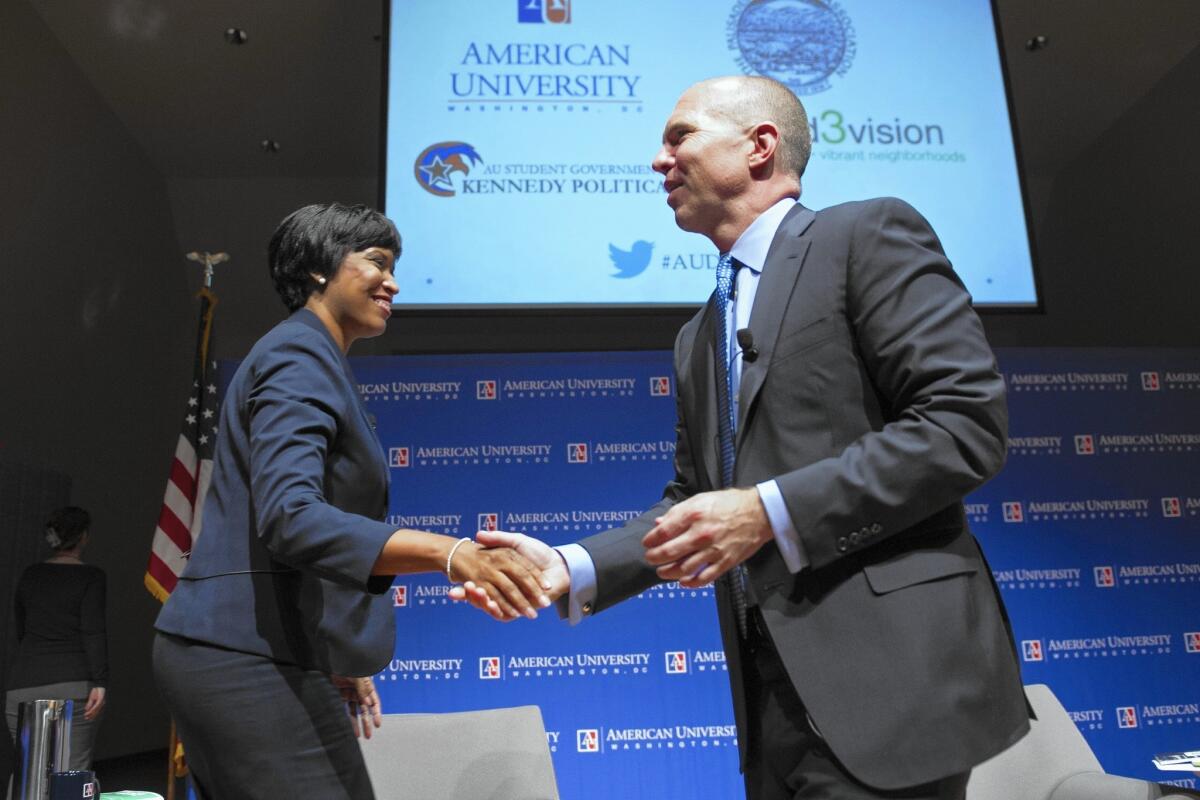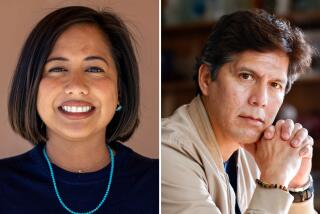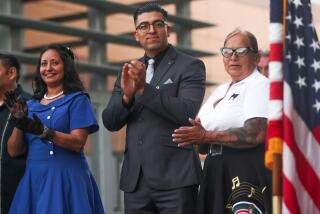D.C. mayoral hopefuls tapping into concerns of city’s longtime residents

- Share via
Reporting from Washington — At the annual 17th Street High Heel drag-queen race here, as competitors teetered in gold sequins, beehive hairdos and fishnets, mayoral candidate Muriel Bowser told a joke and posed for photos outside an oyster bar. Blocks away, her challenger, David Catania, was also in the crowd, marching in a parade.
Later, when contestant Urethra Franklin was declared the winner over two-time champion Inertia Dolce, Bowser and Catania were there too, posing for photos with finishers.
A drag-queen race may be an unconventional campaign stop in some elections, but not in the District of Columbia, a mostly liberal city where, statistics show, the population is increasing, unemployment is dropping and sale prices of homes and condominiums are rising. The Dupont Circle neighborhood where competitors in drag strutted past cafes and restaurants is one of the city’s most desirable after years of blight.
The progress is not without a cost. Younger, predominantly white professionals are flooding neighborhoods long home to thriving, mostly black middle and working classes and driving the cost of living out of reach for many longtime residents, a review of analyses and government data show.
The average price of a single-family home hovers in the $800,000 range, with the average rent on a one-bedroom apartment roughly $1,500, according to government estimates.
“This has been D.C.’s story for a long time, this tale of two cities,” said Peter Tatian of the Urban Institute, who last year conducted an analysis of the city. “But recent changes have made it tougher for the poorer population, because costs are rising very fast.”
The changing city has been an unavoidable theme in the race featuring Bowser, the Democratic front-runner, and her main competitor, Catania. Throughout the campaign, candidates have tapped into growing concerns about the sustainability of affordable housing, good schools and a flourishing middle class.
“I am very proud of the progress that we’ve made together in this city, but I’m also concerned that not everybody in our city is enjoying that progress,” Bowser said at a debate last month.
As the makeup of the city changes, many black voters worry that issues important to them, such as job programs and affordable housing, won’t be a priority for future mayors, said Maurice Jackson, a Georgetown professor who studies African American culture.
“The building in the city is important and people see that,” he said. “But many people feel like African Americans are being pushed out and no one is talking about it.”
Known as a seat of power and for its famous federal monuments, Washington has also been home to generations of African Americans. Abolitionist Frederick Douglass bought a home in the city’s Anacostia neighborhood after the Civil War. Duke Ellington grew up here. And since 1974, when residents were first permitted to vote for mayor, all six mayors have been African American, as is Bowser.
But blacks made up just 51% of Washington residents in 2010, down from 70% in 1980, data show. Neighborhoods that were once heavily African American, such as Columbia Heights and areas around Union Station, gained thousands of new white residents by 2010, the Urban Institute report found.
On a balmy fall day last week, black residents gathered in northeast Washington to talk to early voters.
The neighborhoods of older, single-family row houses, in the shadow of the busy Catholic University campus, showed incremental signs of prosperity, with a renovated recreation center and a few homes bristling with ladders and scaffolding.
Bowser grew up not far from here, and her father, Joseph, waved a “Muriel for Mayor” sign on his daughter’s behalf. As a longtime neighborhood activist, he was cautiously optimistic about the progress as Washington recovers from decades of high crime and the devastating crack epidemic of the 1980s.
“This city is full of cranes in the air,” he said. “There’s more development, more young people. And there’s more opportunity.”
Ricky Owens, a Catania supporter, disagreed. He has lived in the district for more than 50 years, he said, but he can’t afford to buy a house.
“People who were born and raised here should be able to afford to stay,” Owens said as he hoisted a sign for his candidate.
The city’s rebound appears to be driven by younger whites, Hispanics and Asians who moved here in the last decade, according to census data. In contrast to the concerns of black voters that Jackson cited, they have shown interest in public transit, bicycle infrastructure and walkability, as well as new restaurants and businesses, according to Tatian of the Urban Institute.
Employment opportunities in the city are also frequently geared toward younger newcomers, rather than longtime residents.
“The city has lots of jobs, but for many people those jobs simply aren’t accessible,” Tatian said.
The divide has become the backdrop for the mayoral race, in which the latest polls show Bowser, who has served on the City Council since 2007, leading, with Catania, an independent council member, still competitive. A third candidate, Carol Schwartz, a former councilwoman, may siphon away some older voters.
All three have tapped into growing concerns that the city is changing at a rapid pace and that the needs of longtime residents have to remain a priority.
Observers say the candidates have been careful to also support the growing ranks of young people and newcomers who are, at least in part, fueling the recent boom.
“This election is definitely taking place in a changing Washington, D.C.,” said Jamie Raskin, a law professor at American University who follows district politics closely. “The neighborhoods have been transformed in large parts of the city. Both of the leading candidates are trying to respond to the concerns of the new residents of the city.”
Whether members of this younger population will translate into a strong voting bloc is up for debate, experts say. Younger millennial workers may come to the district only for short-term employment and not become invested in local politics, said Natalie Moss, who founded Millennial Week, an annual conference focused on the generation of young people moving into the city.
“Young people are talking about policy issues and about the millennial vote,” Moss said. “But they are not as tuned in to local D.C. politics as they are to things on a national scale. Everyone is really tuned in to the broader picture.”
The candidates acknowledge that the influx of residents that has lifted neighborhoods including Dupont Circle, home of the drag-queen race, shows no signs of slowing. But, they say, they are committed to helping long-term Washingtonians find jobs and education that would allow them to stay.
“There is no stopping the process,” Catania said at the debate. “What we can do a better job of is setting up people to succeed and compete.”
More to Read
Get the L.A. Times Politics newsletter
Deeply reported insights into legislation, politics and policy from Sacramento, Washington and beyond. In your inbox three times per week.
You may occasionally receive promotional content from the Los Angeles Times.










